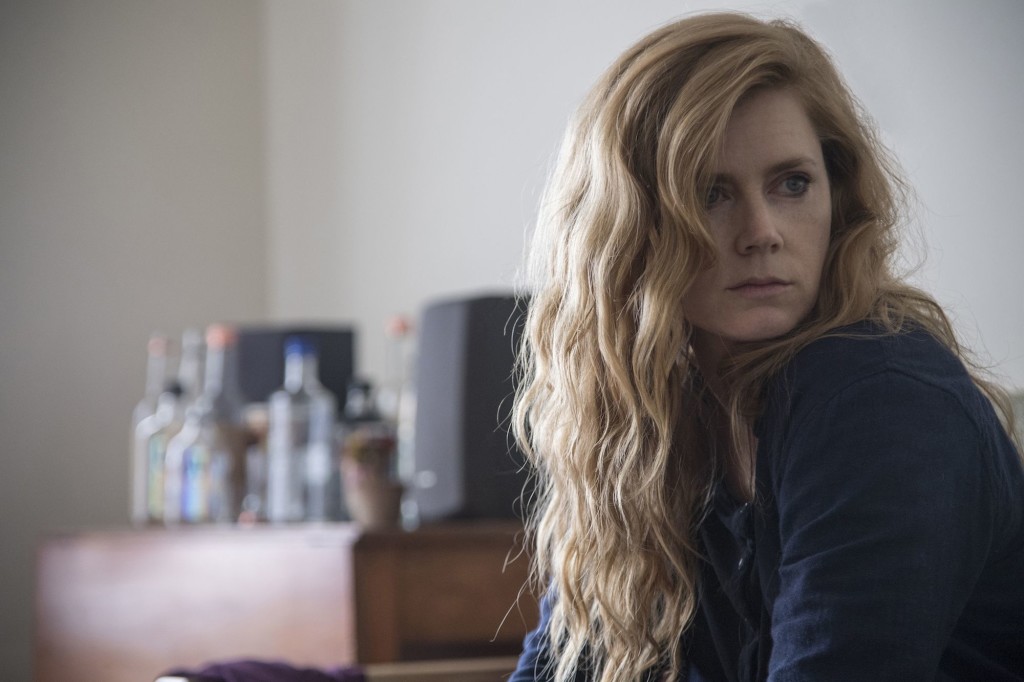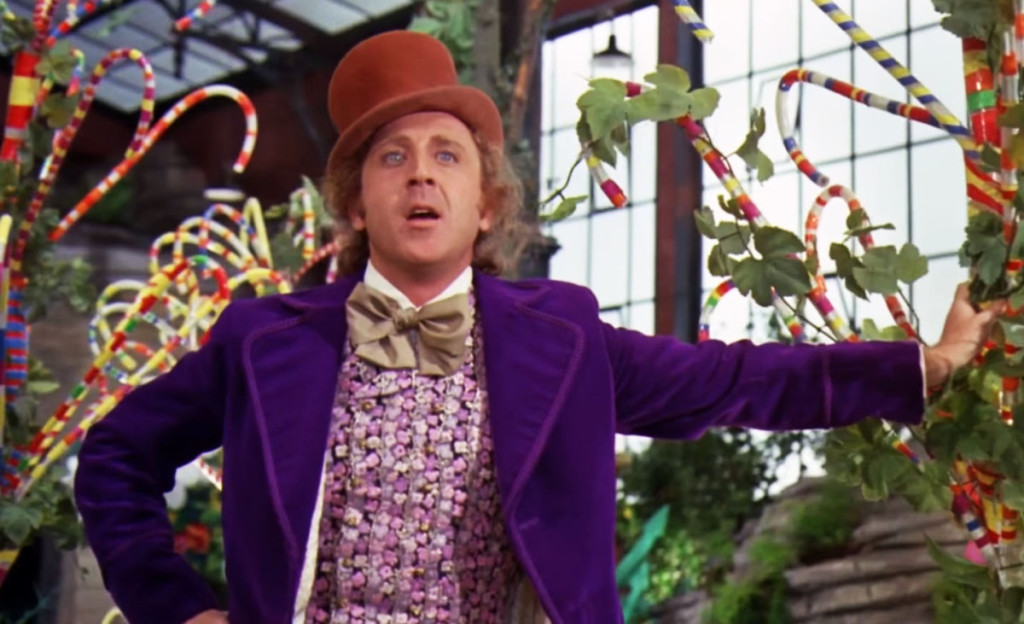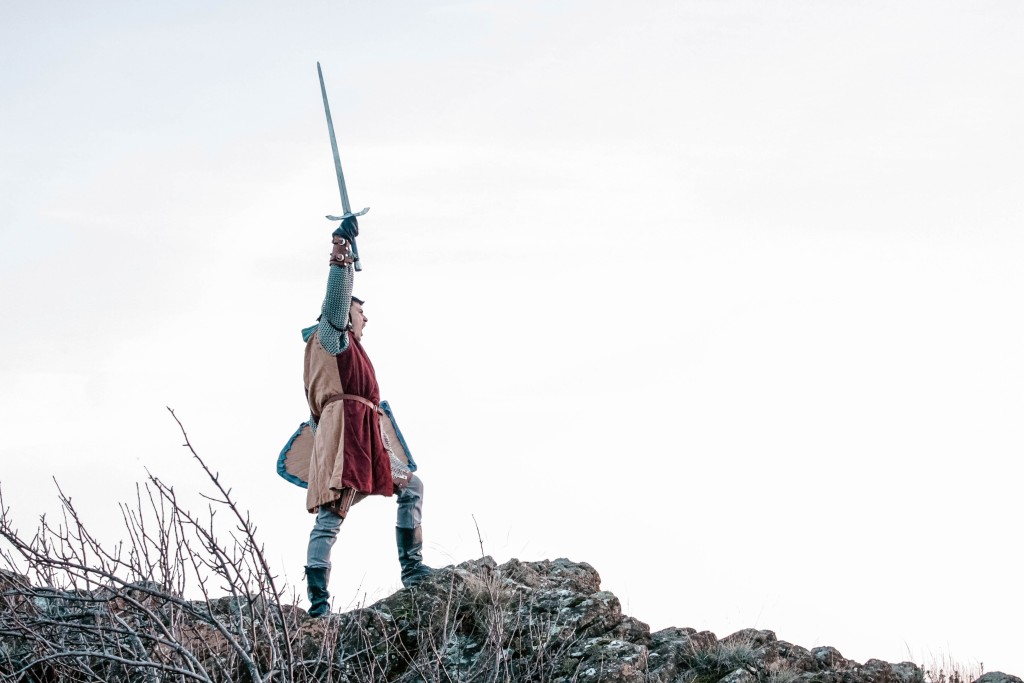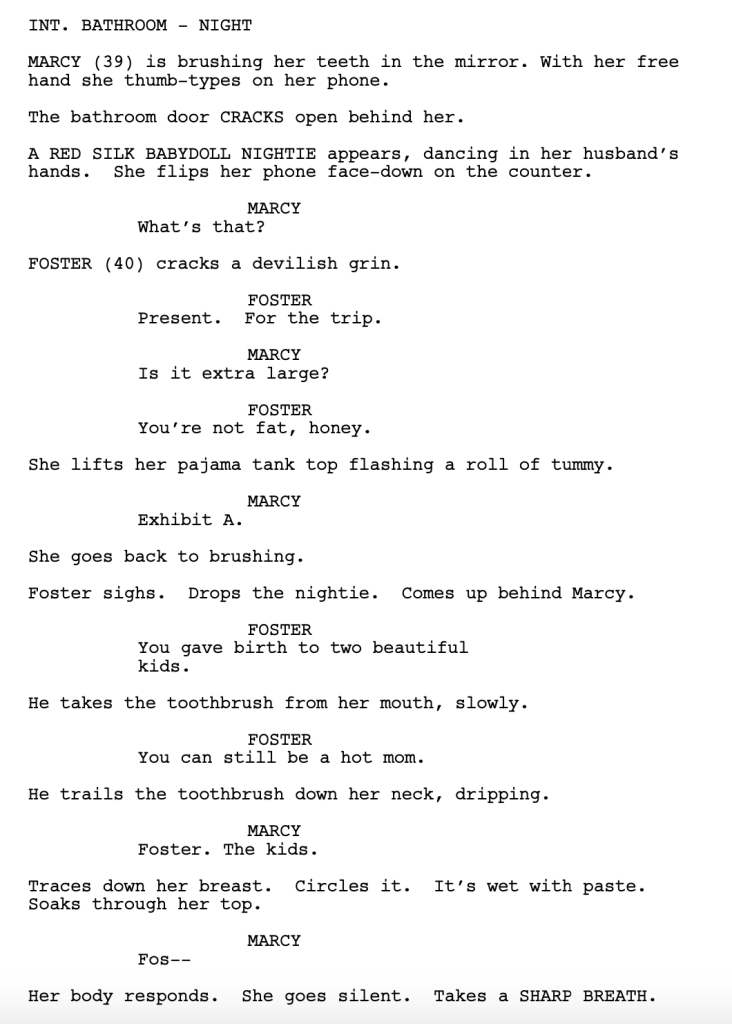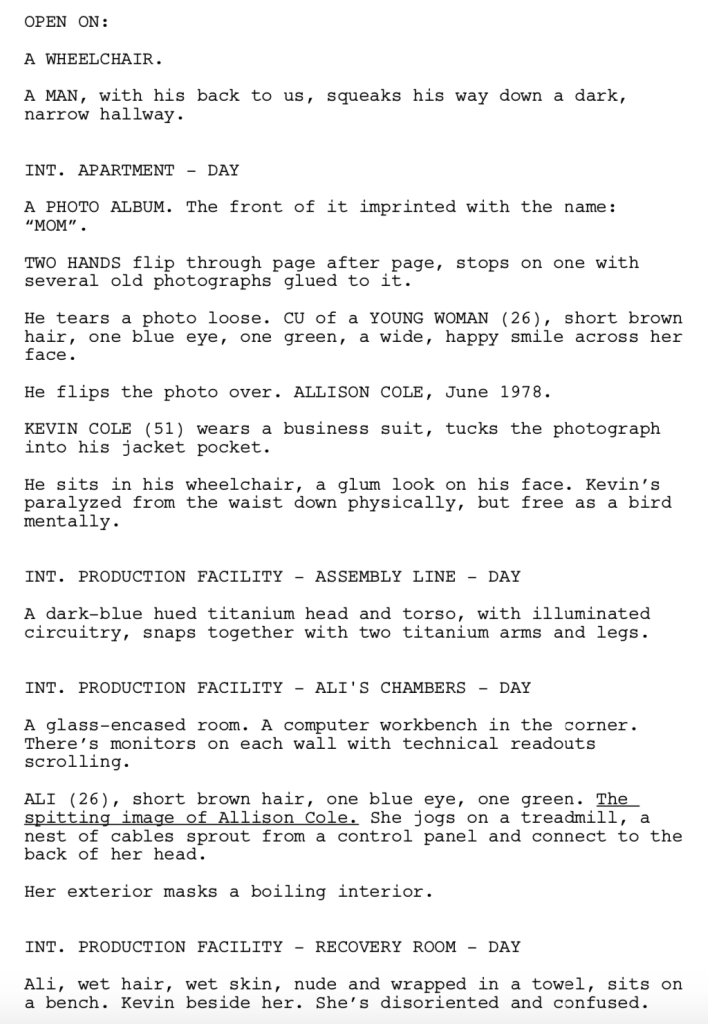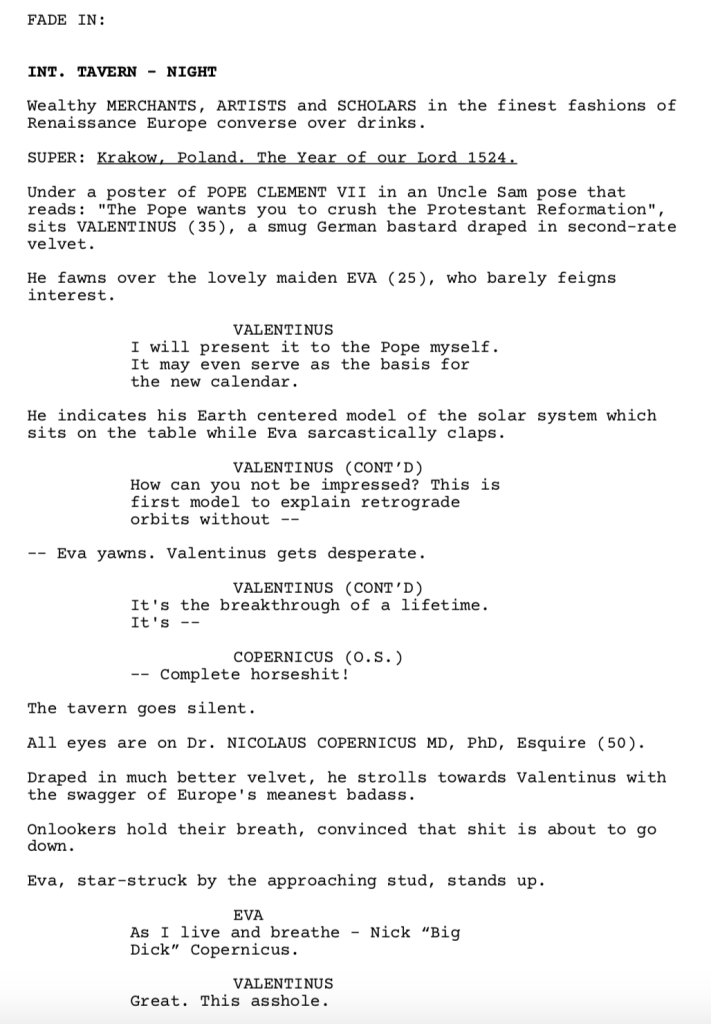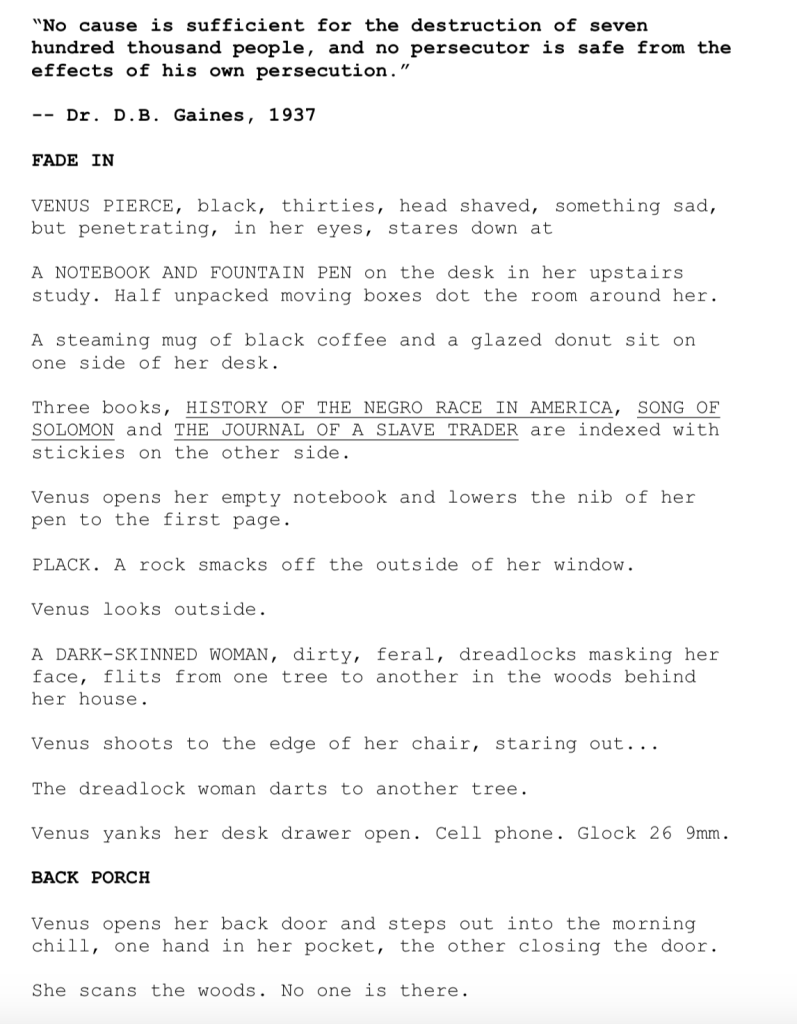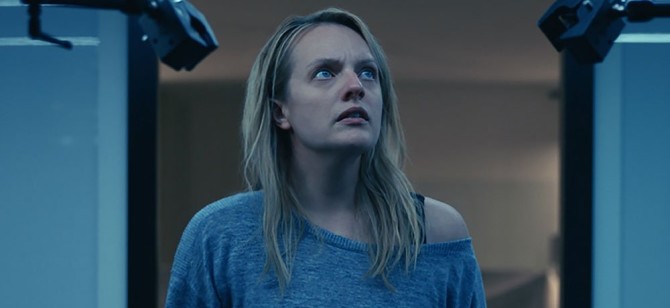What if I told you that someone just wrote the female version of Joker, and that it’s actually better than that movie?
Genre: F#@%d Up
Premise: A single mother in New York City begins seeing a mysterious older man from her past around town and becomes convinced that he’s come back into her life to kill her daughter.
About: This one finished with 8 votes on last year’s Black List. Writer Andrew Semans has been writing and directing short films as far back as 2000. His only feature is a 2012 movie called “Nancy, Please” about a man who must retrieve a precious book from his former girlfriend.
Writer: Andrew Semans
Details: 110 pages
To be honest, I’m not entirely sure what I just read.
But I can tell you this. I read from the first to the last page without getting up, without checking e-mail, without going to Youtube, and without checking my phone. I can’t remember the last time that happened.
This script was so freaking weird but simultaneously so amazing!
I don’t know where to start. It’s unlike anything I’ve read before. We’re all trying to answer that everlasting question: What are readers looking for? This is what they’re looking for. Someone with a unique voice. Someone who looks at the world differently, who focuses on things that the average person can’t possibly imagine.
Us readers are so starved for originality that we’re like kids in a candy store when we finally get it.
I have no idea what’s going to come of this script but I can promise you this. A big actress will kill to star in it. This is an actress’s dream role. It has Oscar written all over it. And the writing is so atmospheric and weird (in a good way) that I’m guessing a major director gets involved as well.
I’m reluctant to summarize the script because I want it to be a surprise so why don’t those of you with access to the 2019 Black List scripts (hint hint, check the comments section) go grab this script, read it, then come back.
40-something Margaret works at New York biotech company, Biomatrix. When we first meet Margaret, she seems like a strong, if slightly offbeat, woman. She’s telling her young co-worker, who’s dealing with a controlling boyfriend, how to stand up for herself. How to set boundaries in the relationship.
When Margaret gets home, we learn she has a 17 year old cool daughter, Abbie (When Margaret texts her questions like, “Status,” Abbie texts back, “Shooting heroin”). While there’s nothing overtly dysfunctional about their relationship, we get the sense that Margaret is a bit overprotective.
One day, while on the train to work, Margaret spots a man in his 60s. Overcome with fear, she races out of the train at the next exit. A couple days later, she sees the man again in the park. This is David. Or, as we’ll come to find out, this is who *she thinks* is David, a man she was involved with from the past.
Margaret starts following David around the city and eventually confronts him, tells him to stay away from her daughter. But David, or the man who she thinks is David, says he has no idea who she is.
Margaret’s world begins to crumble. She starts spending more time at home, obsessively keeping an eye on her daughter. She goes to the police to tell them about the man, but they point out that this guy hasn’t called or approached her. There’s nothing they can do.
As time goes on, we learn more about Margaret’s past with this man. When she was 19, she stayed at a remote science lab with her parents. That’s where she met David. He swept her off her feet. But soon, he began making her do things – he called them kindnesses. Small things like not wearing shoes all day. Standing still for an hour. But the kindnesses became more difficult. He kept asking more and more of her.
Margaret eventually got pregnant, and nine months later, had their baby. Her son became her world. Until one day, she came back home to find her baby missing. **And this is where s@#% gets weird** David ate their baby. Not to worry, he says. The baby is still alive, inside of him. If she wants to be with her baby forever, she must stay with him.
But Margaret ran. Ran as far away as she could. Went and had Abbie. And for 20 years, created another life. That is until now. David is back. And he wants to be with Margaret again. He’ll start with a series of small kindnesses. And he’ll go from there…
I KNOW.
It’s weird.
But it’s not the kind of script you can judge from a summary. This script is about its nuances, the cracks and the holes in the wall are where this story lives. It’s so specific and odd and offbeat that you can’t appreciate it unless you read the thing.
I’ll start with the obvious. There’s a sophistication to the way Margaret’s mental state is approached. I see writers trying to write crazy people all the time and they treat crazy like a 10 year old sees crazy. Overly simplistic “crazy” actions like randomly screaming and saying weird stuff.
Movies like Resurrection only work if we believe the craziness. And I knew right away that this writer understood crazy. Margaret obviously has some deep-rooted PTSD that she’s repressed for years and it’s all coming out at once. Her mind is like a popcorn popper. No matter how hard she tries, the kernels keep popping out of her skull.
The thing is, I usually hate scripts about “are they or aren’t they crazy” characters. But when I read a script like Resurrection (which needs to be retitled “Margaret” right away), I’m reminded that a good writer who understands the sophistication behind how people lose their minds, can make it work. It’s that old adage of don’t write something you’re not capable of writing.
I don’t understand the stock market. I’ll never understand it. So if I tried to write a movie about the stock market, it would be terrible. Same thing about mental states. If you don’t truly understand how the mind works, don’t write a crazy character. It never comes off believably. I know this because I read tons of these scripts.
Getting back to Resurrection – this is a script that has a plot. But the real reason we keep reading is the main character. And I think that’s where you find the best scripts. When you’re turning the pages because the character is so interesting and not because you want to find out what the next plot point is.
The specific reason why Margaret is so compelling is because of the contrast in her character. We meet her as this strong, intelligent, determined hard-worker who’s very successful. But, the more we get to know her, the more we realize how fragile she is. That’s where characters come to life – when their external is opposed to their internal. Because that means they’re always going to be in conflict and we’ll want to read to find out how that conflict is resolved.
That’s why I read through this so obsessively. I wanted to know if Margaret was going to fall into insanity or if her external strength was going to pull through.
But don’t get me wrong. The plot was strong as well. We had a clear GSU. The goal was to kill David. The stakes are the safety of Margaret’s daughter. And the urgency is David threatening to kill Abbie soon. So it still works on a basic storytelling level. But the character of Margaret just took this script up 15 levels. She was such a great character. I couldn’t turn away.
If they get the right package of people working on this, this is going to be the first ever Taxi Driver slash Nightcrawler slash Joker with a female lead. And not a lip-service version either. This will stand toe to toe with those movies if it’s done well.
Wow! This was a wonderful surprise.
[ ] What the hell did I just read?
[ ] wasn’t for me
[ ] worth the read
[x] impressive (TOP 25!!!!)
[ ] genius
What I learned: There’s something about great screenwriters I haven’t yet been able to quantify. They seem to be able to write weird WITH A PURPOSE. I read a lot of weird scripts. But it’s usually sloppy weird. “All over the place” weird. There’s no rhyme or reason or plan to the weirdness. Whereas with this script, which has a man who claims to be carrying a woman’s child that he ate for the past 20 years in his stomach, the weirdness has purpose. It feels organic to the story. I still don’t know how to explain the difference. All I can tell you is that writers like Semans are able to take offbeat chances and yet back them up with a plan. They’re connected thematically. They’re set up well. They’re paid off well. It isn’t just someone throwing whatever they can think of in the moment at that wall. That’s when weird gets sloppy. So even though you have an “original voice,” that voice is too wild to be taken seriously. You need the ying (structure) with the yang (weirdness).
Ridley Scott’s first ever TV show!
Genre: TV Drama/Sci-Fi
Premise: Two atheist-programmed androids are tasked with raising human children on a mysterious virgin planet but their plan is compromised when a second God-fearing ship of humans arrives.
About: This is a big one. It hails from Aaron Guzikowski, who sold his spec, Prisoners, for 1 million dollars back in 2009. The show is being directed by Ridley Scott and will be one of the big-ticket items HBO is using to get you onto their upcoming streaming service, HBO Max.
Writer: Aaron Guzikowski
Details: 66 pages
Today’s writer has an interesting history. He won one of the rare 7 figure spec script lottery tickets back in 2009 for his script, Prisoners. It was one of the hottest projects in town at the time, but the script wasn’t as good as people were making it out to be. The core conflict of a man torturing the guy he thought kidnapped his daughters was interesting. But the puzzle behind who the killer really was was a mess. It didn’t make sense.
So it wasn’t surprising to me that Guzikowski hasn’t done much since Prisoners. He had a TV show nobody saw and got the scripting gig for the Papillon remake that nobody saw either but that’s it. In an entire decade.
I don’t think he was ready. And that’s one of the things aspiring writers overlook. Everyone’s trying so hard to break down the doors but if you break down the doors too early, people are going to realize quickly that you can’t write. So don’t feel bad if it takes longer than you want it to. You’ll be more prepared when those giant doors open.
To Guzikowski’s credit, he stuck it out, and now he’s being rewarded in the biggest way. Ridley Freaking Scott has chosen Guzikowski’s script to make his TV debut with. And with deep pockets HBO footing the bill, you know this is going to look great. Let’s see if the pilot is any good…
Androids Mother and Father land on a planet called Kepler-22b, which is 600 light years from earth. It’s the closest planet earthlings can escape to after their planet became uninhabitable due to war.
This future squabbling earth can be divided into two categories – atheists and believers. The atheists don’t care about God and therefore could afford to send a ship out with two robots and a bunch of human embryos. Meanwhile, the believers had to put together a ship that could actually carry humans. For this reason, the much smaller android ship gets to Kepler-22b ten years before the other big lumbering ship.
Once they arrive on this sorta-earth like planet (it’s a little grayer and more depressing than earth), they set about trying to grow babies. They’re able to bring six embryos to life, but over the next decade, all of the children die except for the youngest, Campion.
Since they can no longer keep the atheist race going (without females) Father gets the idea to send out an SOS to the arriving God ship to come pick Campion up. He does this behind Mother’s back because Mother seriously, and I mean SERIOUSLY, hates the God people. When Mother finds out what Father has done, she kills him.
But it’s too late. The God people show up. Now remember, these two sides were in a war with each other. So things get testy right away. The God people try and kill Mother but, in a shocking twist, she reveals that she’s one of the super-weapons that the atheists used to scorch earth. She steals their lander ship, goes up to their big ship, and crashes the thing. But five children were able to escape and fly back down to earth, where they join forces with Campion. He will now have to teach them how to live on this land. All while avoiding…. Mother.
Hmmm….
Well, Raised by Wolves is nothing if not interesting.
It’s unlike anything I’ve read in a while. And if you’re an adult sci-fi geek, this is probably going to satisfy your science-fiction needs.
But I’m not sure what to make of it.
It’s sort of all over the place.
Take the droids for example. In any other scenario, the droids would be foolproof. They’re the ones who can stick around for centuries because they don’t degrade. They’re 1s and 0s. But these robots are some of the crappiest robots ever constructed as they start falling apart almost immediately. Ten years into their journey and they can barely function.
On top of that, the droids have full-on human emotions. I would argue that they’re more emotional than the human kids they raise. Both Mother and Father are constantly dealing with depression after the death of their children.
The hook here is humans raised by robots. But if the robots a) aren’t built like robots and b) aren’t emotionless like robots……… are they really robots??
I might have overlooked this if the plot was strong but the whole thing feels like it’s stuck in second gear. You’re waiting and waiting for it to finally step on the gas but it’s this long drawn-out growing-up story where we keep hitting the same beats over and over again (brothers and sisters die – it’s sad).
Then, at the last second, Mother becomes this super-weapon from back on earth who was somehow reprogrammed to be a robot parent or something and all I could think was, “Wait, what!?” Why did her creator recycle the very weapons that destroyed earth to create a robot when he could have just… oh, I don’t know… used a normal robot that wasn’t a planet killing super-weapon??
It didn’t make sense at all.
Then now you have these other kids from the ship who are best friends with Campion and what is the show going to be about? They’re going to run around and hide from Mother for ten episodes? Is that a compelling story?
Things looked a lot more interesting when the whole ship of 100 people was going to land and start a second colony. That had more potential for interesting story ideas in my opinion.
I’m not an expert on television like I am on features, but if there’s one thing I know about pilots, it’s that when you leave that first episode, you need to know exactly what the show is and the upcoming story needs to look exciting. After the end of Raised by Wolves, I don’t know what this show is about nor does it look exciting.
I suppose you could focus on a group of kids growing up on this planet together. The pilot spends a TON of time mentioning that the planet was once occupied by giant lizards. So I’m guessing those lizard creatures are going to come back to alleviate some of our sci-fi needs. But I’m not sure six kids, a few big lizards, and a crazy mom-slash-superweapon are enough to build ten compelling episodes around.
I hope Ridley Scott comes in here and directs the hell out of this thing and proves me wrong cause I’d like nothing more than a cool new sci-fi show to watch.
[ ] What the hell did I just read?
[x] wasn’t for me
[ ] worth the read
[ ] impressive
[ ] genius
What I learned: You have to stay true to your hook. If you promise a show about humans raised by robots, you need to give us humans raised by emotionless fact-based androids. If you make the androids act exactly like humans, you’ve compromised the whole point of the show.
It seems strange to say there’s nothing to watch in the era of 15,000 TV shows but THERE WAS NOTHING TO WATCH THIS WEEKEND! While scrolling through Netflix, I somehow ended up on Willy Wonka and the Chocolate Factory (1971), a movie I hadn’t seen since I was a kid but remembered loving.
I always find it fascinating to rewatch these beloved classics to see if they still hold up and I was shocked to find that Wonka held my interest from the first to the last frame. A big surprise considering how screenwriting-unfriendly it was.
For starters, almost every single character in the movie is unlikable. Veruca Salt is unlikable. Augustus is unlikable. Violet. Mike. Even Willy Wonka is a smarmy jerk. The only two characters who are likable are Charlie and Grandpa Joe, although they don’t get all that much screen time once we’re in the factory.
How is it the movie still works, then? Well, Charlie may be one of the most likable protagonists in history for one. That helps offset a lot of the negativity. Which is a good lesson for aspiring screenwriters. If there are a ton of unlikable people in your script, make sure your protagonist is extremely likable.
Another cool thing about Wonka is that the whole movie is a series of impending mystery boxes. Which room are we going to next? What will be inside? This ensures we’ll keep watching. We want to see what the next room has in store. This same setup would not have worked if, say, Willy Wonka had taken the five children camping.
Finally, as a kid, I never paid attention to themes. But watching the film now, the theme is very apparent. If you’re mean or selfish or a glutton, bad things are going to happen to you. I used to think of theme as this complex equation that needed to be half-statement half-question and include its own three-page thesis paper when, in reality, the most effective themes are very simple, like this one.
But the big lesson here is when you have a problem in your script, you need to have a gameplan to overcome it. With so many bratty kids and this dark heartless candy factory host, you need to be able to say, “Here’s what I’m going to do to offset that.” The most likable protagonist ever and a series of mystery boxes did the job.
Willy Wonka reminds us that no matter how old a movie is, when it works, it works. Even with its slow-by-modern-standards first act, once you start watching Willy Wonka, it’s impossible to stop. Try it out. It’s on Netflix.
Bringing us into the modern era, there have been a surprising amount of script sales as of late. As for why this is happening now, I’m not sure. Especially because I can’t remember the last high profile script sale before this year. But I’m not complaining. Let’s take a look at what’s selling.
The first is probably the most shocking. Simon Kinberg, whose last spec sale was Mr. and Mrs. Smith (he’s since gone on to produce and write many of the X-Men movies) sold his spec, “Here Comes The Flood” to Netflix for – get this – MID SEVEN FIGURES. That would make it one of the biggest spec sales ever. Frustratingly, there isn’t a full logline. We’re only told it’s an “elevated, character-driven love-story heist movie, with the heist playing out in increments.” It literally sounds exactly like Mr. and Mrs. Smith, but with criminals instead of agents.
Another key detail to this sale is that there is no director or actors attached. This is mighty good news for aspiring writers if Netflix is buying material without elements. The naked spec script is back, baby!
Next up we have Johnathan Stokes, who sold his spec script, Murder in the White House, to Paramount for mid-six to low-seven figures. Although Stokes has made the Black List numerous times, I was surprised to look back into my archive and see that I’d never reviewed one of his scripts. I remember seeing his 2013 entry, TCHAIKOVSKY’S REQUIEM, about a conductor who investigates the great composer’s unnatural death and unlocks the mysteries of the man himself while preparing to debut Tchaikovsky’s final symphony. But I guess I never read it.
The logline for this one is as follows: “The president is murdered during a private dinner, and a female Secret Service agent has till morning to discover which guest is the killer before a peace agreement fails and leads to war.” I’ve always been a fan of people murdered in high profile situations. I once had an idea for a murder in Area 51. Not sure why I never wrote it. It’s an easy way into a high-concept world. Curious if this will be any good.
Next we have “Fast and Loose” from the writing team (Jon and Erich Hoeber) who brought you Meg. This one actually sounds interesting. It follows a man who wakes up in Tijuana after being left for dead with absolutely no memory. As he follows a string of clues to uncover his identity, he discovers that he’s been living two different lives: one, as a super-successful Crime Kingpin, surrounded by beautiful women, expensive toys and a lavish lifestyle, and the other as an undercover CIA agent, but with a puny salary, no family or home life whatsoever and zero trappings of success. The problem is, he can’t remember which of these two personas is his true identity.
Talk about a big concept! Reminds me of that 2011 film with Liam Neeson, “Unknown,” which covered similar territory. That film had a great hook. Our hero shows up to a big conference with his wife, gets in an accident, goes back to his wife, and she says she has no idea who he is. But it kind of fell apart after that. This one comes from John Wick co-director David Leitch’s production company, 87North.
So what can we learn from these sales? Well, they’re all big ideas. Heists are ALWAYS marketable. You don’t even need to come up with that amazing of a heist idea. If it’s exploring a heist in a slightly different way, it’s got a chance at selling (assuming it’s good of course). For the White House spec, if you have a dead body, you have a movie. Especially if that dead body is the president. And the last sale is also based on a time-tested trope: amnesia. I know how much some people hate amnesia concepts but as long as you can find something interesting to do with the amnesia, you’re good.
What’s interesting is that versions of ALL THREE OF THESE IDEAS could’ve been written 30 years ago. 60 years ago. Even 100 years ago. Certain setups just work. Why mess with them?
But this last idea is where I draw the line. It’s the most Hollywood of Hollywood projects and I’m predicting bomb central right here, right now. The project is titled “Ball and Chain” based on a 90s comic no one heard of and here’s the description: “Edgar and Mallory Bulson have decided to throw in the towel. That was the plan anyway, until a mysterious meteor bathed the battling couple in extraterrestrial energies that gave them super-powers. Will their newfound abilities be enough to make their marriage work?”
Meteors giving characters powers is the trope to end all tropes. It’s not allowed to be used anymore. This sounds like a bad version of Hancock which was already bad on its own. It’s got Emily Gordon scripting, who did a great job with The Big Sick. But this is a husband-wife superhero movie. It’s a million degrees removed from The Big Sick. It, of course, is going to star The Rock and Emily Blunt. This feels like one of those ideas that nobody in any creative position was actually a part of. It was all decided upon by suits and agents then delivered to the talent later via e-mail. God does this sound bad.
But other than that, I hope everyone had a wonderful Mother’s Day!
Where screenwriters rise from the ashes to prove once and for all, the voters got it wrong!
I know. A lot of you are angrily checking your e-mail, confused about the lack of a Scriptshadow Newsletter inside when I promised you it was coming at the beginning of the week. What’s going on, Carson!!? Hey, I’m right with you. I want that newsletter to show up, too. The problem is this week has been bumpy and I haven’t had the time to get it written. These things are 10,000 words long so they’re not easy. And maybe it’s good that it’s delayed. The trades are posting about a new script sale every day. Where are all these sales coming from? Maybe it has something to do with the coronavirus and the need for material? It’s 1996 all over again.
But hopefully, this will tide you over. Everyone deserves a second chance to make a first impression. So today we’re going to pit scripts against each other that barely lost out in their respective Amateur Showdowns. I’m hopeful that we’re going to find an undiscovered gem because when I went back and looked at all of these loglines, I thought to myself, “Man, these all sound like good movies.” So now I leave it up to you to find the best of the second best.
For those new to the site, Amateur Showdown is an occasional tournament I hold on the site where I pick five screenplays that were submitted to me. Then you, the readers of the site, read as much of each script as possible and vote for your favorite in the comments section. Voting closes Sunday 11:59pm California time. The winner will receive a review the following Friday that could result in props from your peers, representation, a spot on one of the big end-of-the-year screenwriting lists, a partnership with yours truly, and in rare cases, a SALE!
I am taking submissions for the next Amateur Showdown, which will take place between 4-6 weeks from now. So get your entries in. E-mail me at carsonreeves3@gmail.com. Include your script title, the genre, a logline, and a pitch to myself and potential readers why you believe your script deserves a shot. It could be long, short, passionate, to-the-point. Whatever you think will convince someone your script is worth opening, make your case. Just like Hollywood, the Scriptshadow readers are a fickle bunch. So be convincing.
Good luck everyone!
Title: Emergent (new draft)
Genre: Sci-fi/Thriller/Romance
Logline: A brilliant programmer gets embroiled in a bizarre and dangerous love triangle between a co-worker that saved her life and an artificial intelligence that nearly killed her.
Why You Should Read: Emergent had a good contest run last year, placing as a Quarterfinalist or above in Nicholl, Page, Austin, and Big Break as well as a few others. It landed me a few queries and even a couple meetings with managers, but no bites on it yet. I’ve since made some revisions (based on feedback from said meetings, etc.) and will be sending it out again this year. I’d really love to hear the opinions/advice/feedback from the scriptshadow community and even get it reviewed. Cheers.
Title: The Fire Tower
Genre: Contained Thriller
Logline: When a family on vacation to a remote fire lookout tower rescues an injured female hitchhiker, they wind up in a battle for their lives.
Why You Should Read: When I was 10, we went on a cross-country camping trip out west. One night we got horribly lost on a winding road, high in the mountains. Out of the darkness a hitchhiker jumped in front of our car asking for a lift. We gave her some water and snacks (but my mom wouldn’t let my dad give her a ride). Later, I was told that a whole family had disappeared without a trace not far from there. That was the seed of the story. But I needed a contained space to trap my family.
Lookout towers have been used in the United States for 100 years. At the peak of their popularity in the ‘40s, the U.S. had about 8,000. Today, there remain about 85 fire lookout towers in the U.S. in extremely remote mountain areas in the National Forests which you can rent for $25-$75 a night.
Title: Kamikaze
Genre: Action
Logline: After her creator is killed in a terrorist attack, an emotionally charged android, suffering from a fatal virus, struggles to hunt down the mercenaries responsible.
Why You Should Read: Kamikaze is a non-stop, can’t catch your breath action script. It’s placed very well in screenwriting competitions (finalist), it nabbed me a manager (we’ve since parted), but the script hasn’t gotten much traction. I’m really wanting to know if there’s something I’m missing, and if I genuinely have what it takes to make it. — The main character, Ali, in an android that can’t seem to keep her emotions in check, which is a major drawback to those that created her. The script plays with the concept of logic vs. emotion and how they can help/hinder in various situations. — Thank you for the opportunity to give it a read.
Title: Renaissance Men
Genre: Action, Comedy
Logline: In 16th-century Rome, astronomical badass Nicolaus Copernicus seeks papal approval for his radical new theory about the universe, but after he’s framed for the Pope’s kidnapping, he’ll risk his life and legacy to track down the real abductors.
Why You Should Read: I’ve always loved history. I just wish it could be funnier. If I had a time machine, I probably wouldn’t use it kill baby Hitler. Instead, I’d just swap him with baby Charlie Chaplin who was born a mere four days earlier. But since the latest version of Final Draft is easier to get my hands on than a functioning time machine, I decided to write Renaissance Men. A hilarious adventure that pits some of Renaissance Europe’s biggest egos including Copernicus, Machiavelli, Nostradamus and Michelangelo against each other in a high stakes game of cat and mouse.
I had many reasons why I wanted to write this. First, I knew it would be a lot of fun. Second, I was sure I could generate a ton of laughs. And last but not least, because a story about how the rich and powerful will cover up scientific truth to protect their political interests is even more relevant today than it was 500 years ago.
Title: THE BLACK PETREL
Genre: Horror/Thriller
Logline: A frustrated novelist goes to an old Southern hotel looking for inspiration and finds herself trapped in a nightmare with five strangers and a vengeful ex-slave.
Who am I: A writer trying to feed a hungry audience something delicious.
Why You Should Read: If GET OUT and A NIGHTMARE ON ELM STREET got pregnant listening to a Nina Simone song, this is the baby that would pop out.
This week I talked to not one, not two, but THREE separate writers who were all having the same problem. They were having trouble coming up with a movie idea to write. Movie ideas are probably the most debated aspect of the screenwriting process. Everyone knows when they see a good one. And yet coming up with your own good movie idea remains the most challenging part of the process.
That’s because we don’t judge our ideas the way we judge others. We judge other ideas with objectivity. If it sounds good, we give it the thumbs up. But we create our own ideas out of emotion. There’s an element within the idea – the main character, the subject matter, the theme – that resonates with us on a deeper level. And that’s the problem. That resonance creates rose-tinted glass we see our idea through.
Emotion is not a bad thing, of course. You want emotion when you’re writing a screenplay. But it does get in the way of conceptualizing your idea. You can be so laser-focused on how you’re going to express this element that you can’t see the rest of the idea for what it really is – confusing, or generic, or maybe plain boring. Which is why you always want feedback on your ideas.
But today I want to make the process a little easier for you. What I’m going to do is give you the ten best ways to generate a movie idea. All of these are legitimate approaches to coming up with a good idea. I’m going to start with the worst of these options and move my way up to the best option. Let’s jump into it.
10) Horror and Guns – If you’re really struggling to come up with an idea, write a horror movie or a Guy/Gal with a Gun movie that contains ONE ELEMENT WE HAVEN’T SEEN BEFORE. Like a horror movie where you can’t make a noise (A Quiet Place). These are the two most marketable genres for spec scripts. So when in doubt, write one of these. Because you’ll have the best chance at actually selling them.
9) Follow Your Heart – This is that idea that won’t go away. It’s been sitting in your head for years. It may not be an objectively good idea. HOWEVER. Passion plays a large part in writing a great screenplay. The more passionate you are about something, the more likely you’ll go the extra mile to make it great. So the idea is that you’ll make up for the lack of a big hook by writing something emotionally earth-shattering. That’s how Titanic was written. That’s how Get Out was written. You have to accept that, when you’re finished, you’ll get less script requests. But, hopefully, the people who do request it will be more likely to enjoy it.
8) Update It – If you straight up suck at coming up with ideas, this is a good option. Go back 10, 20, 30 years ago and look for movie types that were popular then. If they were popular once, Hollywood believes they can be popular again. So just bring that genre back with a little modern update if possible. For example, romantic thrillers like Basic Instinct and Fatal Attraction were big in the late 80s. Goofy horror movies like Scream and I Know What You Did Last Summer were big in the 2000s. It doesn’t take a lot imagination to update these genres so it’s an easy way to come up with a marketable concept.
7) Ripped From The Headlines – This is another option for those of you who struggle to come up with your own ideas. Take a hotly debated issue that’s out there in the headlines and build a GENRE movie around it. That last part is key. If you try and build an on-the-nose drama about the issue, we’re going to roll our eyes. Express the execution through a marketable genre. Invisible Man (horror) was about toxic masculinity. Get Out (horror-thriller) was about racism. The Hunt (thriller/satire) was about the political divide. Don’t Worry Darling (Thriller/Sci-Fi) is about toxic masculinity. Right now, this is a great formula for coming up with a sale-able spec.
6) Twist and Shout – Look through all of the time tested movie types out there and see if you can find a way to twist them. So, for example, the buddy cop sub-genre. One of the most reliable formats in movies. “Bright” takes that format and changes one of the parties into an ogre. It was enough to result in a huge spec sale and Netflix’s most watched movie to date. A bigger example would be “It.” A time-tested formula – a young group of friends coming of age during the summer – set in the horror genre.
5) Fascinating True Stories – Find a true story that sounds good and let it do all the work for you. Some writer found a story about JFK saving a dozen people when his boat capsized during World War 2. These days googling, “Great War stories” could find you hundreds of big screen worthy stories that haven’t been told yet. What are you waiting for?
4) An Underdog Story – Underdogs are the most beloved characters in movies. In a medium where writers struggle to come up with heroes audiences give a s@#$ about, underdogs are a cheat code. Forrest Gump. Rocky. Slumdog Millionare. Luke Skywalker. Deadpool. The Mule. The Social Network. Come up with an underdog at the heart of your story and I promise you, your script will be one of the easiest reads of the year.
3) Irony – A good ironic premise instantly separates itself from the pack. Here’s what I wrote in a previous article: “The most basic form of movie irony is to make your hero the opposite of what’s required of him. So you wouldn’t write a story about an atheist who starts his own atheism support group. You’d write a story about an atheist who takes a job as a Christian preacher to make ends meet.” Here’s a whole post about ironic premises.
2) A Fascinating Main Character – This is for writers who are bad at coming up with plots. If your mind doesn’t think that way, do not fear. Instead, come up with a really interesting character then build the bones of the plot around them. Take a look at Arthur Dent (Joker) or Louis Bloom (Nightcrawler) or Max Fischer (Rushmore). In all three of these movies, I’m betting the writers came up with the character first and then formulated the plot pieces around them. The reason you can get away with writing a script that doesn’t have a big plot hook is because everything in this business still comes down to getting bankable actors on board. So if you’re a reader and you see a logline with a really interesting main character, you know if the script turns out to be good you could get a lot of actors interested.
1) High Concept – The biggest, the flashiest, the cleverest, ideas still always win. This is a NUMBERS GAME. That means a certain number of people need to read your script before someone says yes. Therefore, it is in your interest to come up with ideas that get the most people interested in reading your script. The best way to do this is still the high concept idea. How do you come up with a high concept? The best model I know of is the “strange attractor” approach. You must have that thing in your concept that sounds both big and unlike something we’ve seen before. It’s the thing that makes your idea different from everyone else’s. The good news is you can come up with high concept ideas for big movies (The Meg – A group of scientists exploring the Marianas Trench encounter the largest marine predator that has ever existed – the Megalodon shark), medium-sized movies (Split – Three girls are kidnapped by a man with a diagnosed 23 distinct personalities), and small movies (Saw – Two men wake up in a small room chained to the wall with a saw in between them). So you don’t have any excuses. Still the king of the concept creation pack in my opinion.
One of the problems I see writers make is they try to come up with movie ideas out of nothing. They sit at their computer and try to will a good idea into existence. That kind of thing can work under certain conditions. That’s how Bruckheimer and Don Simpson used to come up with ideas. They’d read through the day’s newspapers and magazines until they found a good idea. But that’s generally not how the best ideas emerge. The best ideas come through organic inspiration. You’re out and you see something interesting and your mind goes into, what if that was a movie? You write the idea down and you don’t go back to it. If that idea is still nudging at you three months later, chances are it’s a good idea. Coming up with a good movie idea will always be hard but hopefully this list makes the process a little easier.
Carson does feature screenplay consultations, TV Pilot Consultations, and logline consultations. Logline consultations go for $25 a piece or $40 for unlimited tweaking. You get a 1-10 rating, a 200-word evaluation, and a rewrite of the logline. They’re extremely popular so if you haven’t tried one out yet, I encourage you to give it a shot. If you’re interested in any consultation package, e-mail Carsonreeves1@gmail.com with the subject line: CONSULTATION. Don’t start writing a script or sending a script out blind. Let Scriptshadow help you get it in shape first!

